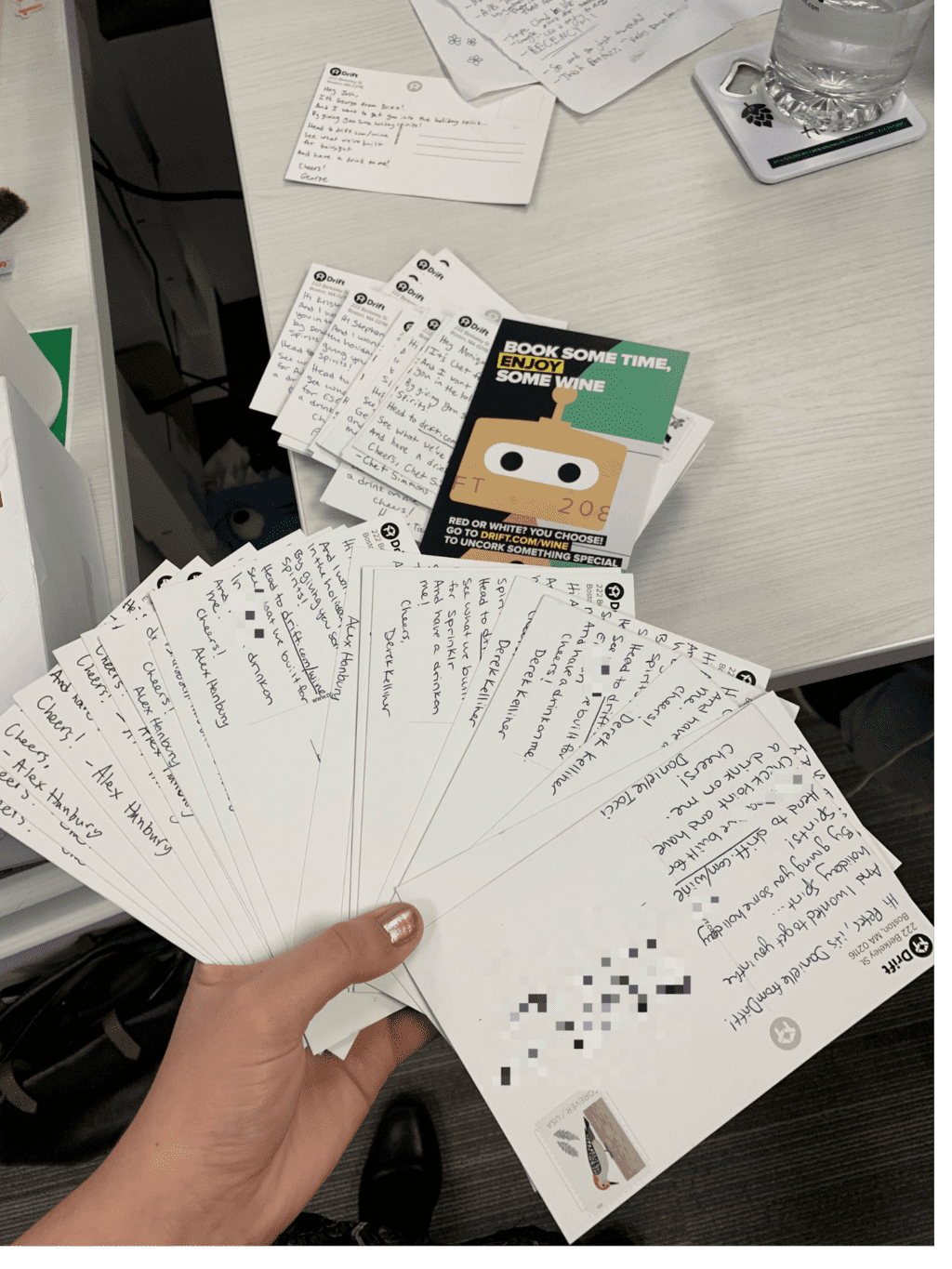4 Ways to Humanize Marketing with Empathy and Build Better Relationships with Buyers
We have more marketing to sales technology to connect with customers today, but they’re tuning us out.
Why? Because marketers and sellers are using technology in a way that is creating barriers to customer connection. For example, I was talking with a VP of Marketing at a learning platform about helping their SDR team get better results with empathy.
We looked at the SDR team’s activities and saw her team was sending tons of emails to targeted accounts each month as part of an automated sequence. When she saw the data, she talked about also getting a “ton of cold-emails” and how she felt like every technology provider put her on their ABM hitlist. And she said, “I delete them all… and they all seem to copy each other’s approach.”
The irony wasn’t lost that her own SDR team was doing the same exact thing to their audience.

Just say “NO!” to sending cold emails!
In our rush to get more leads, drive opportunities and sales, it’s too easy to forget that we need to address the emotional needs (hopes, wants, and aspirations) of our customers.
According to the CMO Council, “Only 20% of marketers are able to predict the next best action for their customers.”
Forrester Consulting discovered, “65 percent of marketers struggle to employ emotional marketing as they turn to automation to improve customer engagement."
We need to go beyond rational-logic based sales and marketing to understand how our customers feel. It’s about improving their experience.
This post is broken out into two sections. In the first section, I want to talk about 4 ways to shift your mindset, which will result in more humanized marketing. In the second section, I want to focus on 4 tactics you can use to bring more empathy to your interactions with buyers.
1. Taking an Empathy-based marketing approach
Empathy-based marketing puts customers’ experience at the center of all our marketing and sales efforts. It begins with understanding our customer’s perspective, desires, and motivations, so we’re relating to them as humans and not objects we’re trying to convert.
It’s grounded in research from neuroscientist Antonio Damasio. He said, “We are not thinking machines that feel; rather, we are feeling machines that think.”
Damasio discovered that every human decision depends on emotion — every single one (even in B2B). When you are marketing to people, you’re trying to get them to do something or buy something you want. That’s object-based marketing.
But when you’re marketing for people, you’re advocating for them. You’re focused on helping them get the result they want or get rid of a problem they no longer want to have. You do marketing from the customer’s perspective. That’s empathy-based marketing
2. Treating people like leads doesn’t work
As our marketing technology, machine learning, and tools become increasingly smarter, so do our customers. Customers know authentic- sincere – communication from the scaled messages we send. They feel it.
Joan Westerberg writes, “Treating people like leads instead of humans just doesn’t work. It doesn’t sell. It doesn’t push you to any level of success. You want to suck at marketing or sales? Dehumanize your prospects. And dehumanize your interactions with them.”
Your customers know what good marketing really feels like. They also sense when you’re sending them scaled or generalized messages. Think about all the automated sequences that we get, one after another after another, or a BDR sending cold emails and following up with the customer like, “I just want to be at the top of your inbox because you didn’t respond to my message last week.”
Sales hustle combined with automation can actually create a bad experience for the customer because it’s about the salesperson or marketer getting their needs me (not the customer). But it’s easy to forget that when we sit at our desks.
3. Knowing we’re not our target audience (or customer)
Saying we are not our customers seems obvious, right?
However, research shows our personal biases and preferences get in the way of understanding customers’ wants, desires, and motivations.
Let me explain: We think, “if I was the customer, how would I feel?” As the customer, “would I like this? or “Would this appeal to me?” This starts our marketing from a bias that’s not customer-centered, and we do this all the time.
For example, I had an email exchange with Brent McKinley, the Director of Business Development at ExeVision, Inc, who shared this great story:
When I was the director for a large tech company in Mountain View, CA, my team printed coffee mugs that said: “I Am Not My Target Audience!!”
This mug has been on my desk for over 20 years, helping me remember to “get outside of my own mind.”
This constant reminder has guided my marketing thinking and my focus on a customer’s needs, more than anything else in my entire career.
I love that. We all should have that mug on our desks as a reminder.
4. MarTech meets the human touch
Why do we do things that we think scale when at their core relationships are not scalable? We must be more human-centered with our marketing.
Here’s what I mean. When you have a martech stack, you need power it with a strong human touch. That means that your marketing team needs to have actual conversations with your buyers.
Use your marketing technology, database, and ability to segment to refine your initial understanding of your target audience’s needs. Focus on helping your future customers achieve what they’re trying to do at each step of the journey.
Is this hard to do? Yes. That said, I believe this is where marketers must focus their energy. This is what makes a better customer experience.
Now let’s talk about four ways to adopt a more empathetic approach.
1. Help like a hotel concierge to create a better experience
If you want to know how to approach applying empathy to your marketing efforts, consider how a hotel concierge operates.
What is their goal? To help meet the needs and be helpful to guests. Why can’t we approach our marketing and sales the same way? Do concierges give the same advice and input to all hotel guests? Of course not.
Still, they’ve prepared themselves to answer some of the same questions. They also do things that don’t scale. For example, what are the best shows? Where are the best restaurants for each occasion? Can I get a reservation now? Where are the grocery or liquor stores, etc.?
But the key is that they listen, they’re available, and their goal is to help. What can we learn? We can approach our customers by doing things intentionally like a concierge.
Find out what motivated them (to download, to fill out the form, to get that report) and help them get that. When I got my team to stop trying to convert leads and focus on helping customers get what they wanted, we got 303% more opportunities in six months.
2. Doing things that don’t scale
There are things that customers expect to be scalable.
For example, email newsletters. Still, they want relevant content. They don’t expect that every single newsletter personalized to their interests. That said, if enough of the content is irrelevant, they’ll unsubscribe.
People mentally unsubscribe before they finally remove us from their inbox. Customers move from interested, to ambivalent, and ultimately apathetic quickly.
Salespeople do things that don’t scale all the time because you can’t automate trust. But you can build trust over time by being intentional, showing you care, and adding value with each touch. That’s at the core of doing things that don’t scale.
That might be:
- Opening Outlook and sending a personal message.
- Picking up the phone talk to your potential customers.
- Writing a personal note in your own handwriting.
- I once got a typed letter (yes, from a real typewriter)</li>
For example, check out this handwritten direct mail campaign:

@drift #humantouch #directmail
Alex Orfao writes on the Drift Blog, “Since we didn’t want this to look like just another mass mail, we made sure the message and handwriting were personal and human. The note was short and sweet (under 50 words) and personalized with the recipient’s name and company.”
This will humanize your marketing quickly: Be an advocate for your potential customers, be curious about them, and actually care about helping them get what they want.
You want to make each person you connect with feel like they matter to you and care about helping them get what’s in their best interest.
3. Develop deeper relationships (not just more of them)
All marketing, selling, and demand generation is about one word: relationships.
It’s not about technology; it’s about people. We need to take the time to go deeper.
This is from a terrific book, The Passion Conversation
We form relationships in two ways. The first way is through dialogue, a virtuous circle of interacting through listening and responding that causes more interaction, listening, and responding. Relationships grow through conversation.
The second way we form relationships is through a process called reciprocal altruism. That’s a fancy term to explain where people freely give to others with nothing expected in return.
Relating to people like this is the heart of empathy-based marketing. It is critical to know what customers want to serve them better. When I interview customers and here’s what I hear made the difference in their buying experience:
“I felt like they were my advocate, they advocated for me and help me get things done”
“They went above and beyond to help me succeed/get a win even though it wasn’t easy”
“I felt like they cared more about me getting what I wanted more than their company’s profit/bottom-line”
See what I mean?
4. Use your empathy superpower
Empathy is your marketing superpower.
We spend too much time getting people to care about what we do.Instead, connect to what your customers already care about. Then you can help them better.
Apply your empathy to move out of your mind and into the intention of the client.
One you know this, you can connect your marketing and sales messaging to what deeply motivates your audience so that you can get results like this:
- A Top 50 SaaS company increased free trials by 32% in one month
- An Inc 500 consulting firm generated 295% more engagement opportunities
- A B2B training company increased email subscribers by 935% with their empathy-powered call to action
You have a choice. To either be me-first (company-focused) or customer-centered.
In sum, you need to seek to understand them first; to know their motivation and learn what they care about to help them get what they really want.
Conclusion
In this post, you learned four ways to adopt humanize your approach with empathy.
Humanized marketing is about building people-first relationships. You do this by intentionally doing things that don’t scale.
It starts with understanding our customer’s perspective and relating to them as people and not objects we’re trying to convert.
When you are marketing to people, you’re trying to get them to do something. But when you’re marketing for people, you’re advocating for them. That’s the essence of empathy-based marketing.
By following these suggestions, I hope you can use them to make a massive improvement in how you connect with your customers to get better results now.
Written by Brian Carroll for Business2Community and legally licensed through the Matcha publisher network. Please direct all licensing questions to legal@getmatcha.com.